- Home
- James L. Swanson
Chasing King's Killer Page 3
Chasing King's Killer Read online
Page 3
King’s activism had propelled him to the forefront of the civil rights movement. He was the most eloquent of the leaders, so he became the spokesman and the symbol. But there were other important leaders, too. It was a cause and a movement that required more than one man to make it happen. King knew he needed help. So he formed a coalition of people and organizations. To win civil rights for black Americans, King pursued two goals simultaneously: He wanted to change the law, and he wanted to change public opinion.
In the first prong of this one-two punch, King decided that peaceful, nonviolent but relentless public protests, demonstrations, marches, and speeches could call attention to civil rights violations. He believed that publicity, especially newspaper and television coverage, could shame the opponents of civil rights. And it could win over people of goodwill—including whites—to the cause. King’s paramount tactic was to influence blacks to resist injustice with nonviolence.
As he led this moral crusade for equal rights for all African Americans, King also emphasized the religious and moral dimension of the cause. Christian ministers, churches, and religious faith played a big role in the fight for civil rights. King often said that he was a Christian minister first and a civil rights leader second.
The second prong of the strategy was to use the law. Civil rights lawyers continued to go to court and challenge unjust and unconstitutional laws, as they had done when they overturned school segregation in the famous case of Brown v. Board of Education in 1954. The civil rights movement sought to repeal laws that discriminated against blacks at schools and in public accommodations like restaurants, hotels, and other places. But King wanted to do more than just overturn bad laws. He wanted the United States Congress to pass new laws to protect the right of blacks to vote, and to have equal access to housing and employment.
King knew he needed to do more than change the law. He needed to change human hearts and minds, too. Racist attitudes had been woven into the fabric of American life for centuries. It was a daunting and gigantic task. Was King was up to the challenge?
In February 1959, Martin traveled to India. He met spiritual leaders and learned more about Mohandas Gandhi’s beliefs in pacifism and the techniques of nonviolent protest, which had been used to win independence for India from its colonial ruler, Great Britain. King’s trip to India influenced the mission he was about to undertake.
On February 1, 1960, the civil rights “sit-in” movement officially began when four black students asked for service at a “whites only” Woolworth lunch counter in Greensboro, North Carolina. When they were not served, the students refused to leave. This method of nonviolent protest spread quickly to other parts of the South. As these sit-ins grew in numbers, enraged whites humiliated them by shouting racist curses and dumping food and beverages on their heads. On October 19, during a sit-in in Atlanta, Martin and fifty other protesters were arrested.
The authorities wanted to teach King a lesson, so, to frighten him, the police jailed him for a prior minor traffic violation. Alone, isolated from his family and friends, he was in danger of harm at the hands of white policemen. On October 26, toward the end of the presidential election campaign, one of the candidates, John F. Kennedy, helped free King from jail. Less than two weeks later, on November 8, 1960, Kennedy won the presidential election by little more than 100,000 votes. Many people believed that his concern for Dr. King helped win votes for his narrow victory.
The next year, in May 1961, the first Freedom Riders boarded two interstate buses in Washington, DC, bound for New Orleans, Louisiana, 1,100 miles away. These initial thirteen riders were a group of seven black and six white pacifists intending to challenge the segregation laws in Southern bus stations and on the buses themselves. White racists met them with violence. Just south of Anniston, Alabama, their bus was burned, and in Birmingham, Alabama, they were beaten by mobs. These attacks revealed the culture of rising violence that Martin Luther King, Jr., faced.
Another group of Freedom Riders that traveled from Nashville, Tennessee, was beaten in Montgomery, Alabama. To protect the riders from further attacks, National Guard soldiers escorted them as far as Jackson, Mississippi. But when they got there, they were attacked, arrested, and jailed.
That fall in November and December 1961, Albany, Georgia, became the focus of new challenges to unfair racial laws. Freedom Riders rode buses and trains to the town and were arrested. In later demonstrations, Dr. King and more than five hundred protesters were also arrested and sent to jail. But protests for equal rights in Albany proved futile because clever local officials avoided violent, public confrontations with the civil rights activists. King considered his efforts there a failure.
In 1962, the movement won a victory when, on October 1, James Meredith became the first black student to enroll at the University of Mississippi—“Ole Miss.” His presence on campus caused student rioting because whites did not want to allow blacks to attend college with them. Federal troops had to be sent to the university to protect Meredith and escort him to class. But behind each victory, there remained the threat of violence.
The year 1963 would prove to be one of the most dramatic and event-packed years of the twentieth century. It would see Martin Luther King’s greatest triumph, and also great tragedies.
On April 12, 1963, Martin protested the segregation of eating facilities in Birmingham, Alabama. After sit-in demonstrations, King was arrested. While in solitary confinement, he wrote what would become one of his most famous statements about civil rights—the “Letter from Birmingham Jail.” It was a response to his critics among the white clergy who claimed that resisting injustice was “unwise and untimely.” King disagreed: “Injustice must be exposed, with all the tension its exposure creates, to the light of human conscience and the air of national opinion before it can be cured.” And he concluded, “Oppressed people cannot remain oppressed forever.”
Nonviolent demonstrations in Birmingham continued the next month. On May 2, almost one thousand black children, from grade school through high school, marched in the streets, singing “We Shall Overcome.” They, too, were arrested and taken to jail. The following day, students kept marching. Eugene “Bull” Connor, the Birmingham Commissioner of Public Safety, ordered the police to use dogs and fire hoses to subdue the protesters. News photos of dogs attacking black children and powerful jets of water knocking them off their feet were published around the world, provoking international outrage against the treatment of blacks, and winning sympathy for the civil rights movement.
Americans—including President Kennedy—watched it all on television. Ugly images of racist mobs exposed the evil of racial discrimination in “the land of the free.” On June 11, 1963, Kennedy decided he could wait no more and gave a televised address to the nation about civil rights:
“One hundred years of delay have passed since President Lincoln freed the slaves, yet their heirs, their grandsons, are not fully free. They are not yet freed from the bonds of injustice. They are not yet freed from social and economic oppression. And this Nation, for all its hopes and all its boasts, will not be fully free until all its citizens are free.”
And he concluded:
“The heart of the question is whether all Americans are to be afforded equal rights and equal opportunities, whether we are going to treat our fellow Americans as we want to be treated. If an American, because his skin is dark, cannot eat lunch in a restaurant open to the public, if he cannot send his children to the best public school available, if he cannot vote for the public officials who will represent him, if, in short, he cannot enjoy the full and free life which all of us want, then who among us would be content to have the color of his skin changed and stand in his place? Who among us would then be content with the counsels of patience and delay?”
Racists who supported segregation and opposed civil rights did not care what President Kennedy said—they were not going to go down without a fight. The very next day, June 12, Medgar Evers, the leader of the NAACP in Mississippi, w
as gunned down outside his home in Jackson by a white supremacist.
To give momentum to their cause, civil rights leaders decided to hold a huge public rally in the nation’s capital that summer: They called it the March on Washington for Jobs and Freedom. On August 28, 1963, more than 250,000 people from all over America gathered on the National Mall to support civil rights.
With the Lincoln Memorial as a backdrop, leaders of religious, labor, and political organizations gave short speeches. Dr. Martin Luther King, Jr., was the last scheduled speaker.
King began reading from his prepared text:
“But one hundred years later, the Negro still is not free; one hundred years later, the life of the Negro is still crippled by the manacles of segregation and the chains of discrimination; one hundred years later, the Negro lives on a lonely island of poverty in the midst of a vast ocean of material prosperity; one hundred years later, the Negro is still languished in the corners of American society and finds himself in exile in his own land.”
But as King spoke, he sounded flat and seemed to lose his place. His speech was not rousing the crowd. King was an experienced and effective speaker, but he had never addressed such a huge audience. The great gospel singer Mahalia Jackson was seated near where he stood at the podium.
She called out to him: “Tell them about the dream, Martin!”
Inspired by Mahalia, King ended the rally with the words of the glorious “I Have a Dream” speech. He began:
“I say to you today, my friends, so even though we face the difficulties of today and tomorrow, I still have a dream.”
Repeating over and over the line “I have a dream,” King told his audience that he believed one day racial oppression would be overcome and that all Americans would “one day live in a nation where they will not be judged by the color of their skin but by the content of their character.”
It was a personal triumph—the most glorious moment in King’s life up until then. In just five years, he had experienced a meteoric rise. In 1958, he had survived a near-fatal stabbing. Now, in 1963, his Lincoln Memorial speech had transformed him into one of the most famous and admired men in the world. The March on Washington created a wildly optimistic mood for the civil rights movement that promised to redeem 1963 from the bad things that had happened earlier that year. President Kennedy invited King and the other organizers of the march to the White House. Anything seemed possible now. At that moment, it seemed like 1963 would turn out to be a very good year after all.
Only a month later, the year 1963 took a disastrous turn. On September 15, the Sixteenth Street Baptist Church in Birmingham, Alabama, was bombed when Ku Klux Klansmen planted dynamite next to the church. When the bomb exploded, four little girls attending Sunday school were killed. Many others were injured. It earned the city the nickname “Bombingham.” King was devastated.
“These children,” he said in his eulogy for the girls:
“unoffending; innocent and beautiful—were victims of one of the most vicious and tragic crimes ever perpetrated against humanity…. So … in spite of the darkness of this hour we must not despair. We must not become bitter; nor must we harbor the desire to retaliate with violence. No, we must not lose faith with our white brothers.”
And as he concluded his sermon, King uttered a heartbreaking farewell: “Good night, sweet princesses, may the flight of angels take thee to thy eternal rest.” It was from Shakespeare’s Hamlet, when Horatio said, “Good night, sweet prince—and flights of angels sing thee to thy rest.”
The killings, as horrible as they were, changed many people’s attitudes and created more widespread sympathy for the civil rights movement.
After those depraved child murders in Birmingham, it seemed that 1963 could not possibly get worse. But it did. On November 22, 1963, a week before Thanksgiving, President John F. Kennedy was assassinated during a visit to Dallas, Texas. His murder stunned the nation. King feared that the tragedy foreshadowed his own fate. As he and Corrie watched Kennedy’s funeral on television, he told his wife, “This is what is going to happen to me.”
Upon the assassination of John F. Kennedy, the vice president, Lyndon Baines Johnson, was sworn in as the new leader of the country. There were many questions. Who was this new man? Some blacks feared the worst about this Southerner from Texas. What were his views on blacks? On civil rights?
Johnson had given a clue earlier that year, at the battlefield of Gettysburg, on Memorial Day 1963. One hundred years after the bloodiest battle of the Civil War, Johnson had delivered a speech as brief as Abraham Lincoln’s Gettysburg Address, and in many ways as powerful. Johnson said that a century after slavery, blacks were not really free:
“One hundred years ago, the slave was freed … One hundred years later, the Negro remains in bondage to the color of his skin.”
Johnson argued that the fate of America depended on ensuring equal rights for all its citizens:
“In this hour, it is not our respective races which are at stake—it is our nation. Let those who care for their country come forward, North and South, white and Negro, to lead the way … The Negro says, ‘Now.’ Others say, ‘Never.’ The voice of responsible Americans—the voice of those who died here and the great man who spoke here—their voices say, ‘Together.’ There is no other way … Until justice is blind to color, until education is unaware of race, until opportunity is unconcerned with the color of men’s skins, emancipation will be a proclamation but not a fact. To the extent that the proclamation of emancipation is not fulfilled in fact, to that extent we shall have fallen short of assuring freedom to the free.”
King’s relationship with JFK had been complicated and sometimes difficult. Kennedy had been a reluctant civil rights warrior. Yes, he had given speeches and hosted civil rights leaders at the White House. But he was distant. His brother, Attorney General Robert F. Kennedy, had worried that embracing King too eagerly might hurt Kennedy’s chances for reelection in 1964. RFK was suspicious of King. He feared King was anti-American and had secret ties to communism.
In Lyndon Johnson, Martin Luther King, Jr., had found, at last, his great political partner. LBJ proved to be an enthusiastic supporter of civil rights. Once out from under Kennedy’s shadow, the real Johnson emerged. In a speech to a joint session of Congress four days after the president’s assassination, Johnson called for the earliest possible passage of a civil rights bill. He was determined to pass the bill within one year, sometime in 1964.
Over the next whirlwind year, the president and the preacher joined forces to create landmark legislation, the Civil Rights Act, which was signed into law on July 2, 1964. This act prohibited racial discrimination in public accommodations, employment, and voting. The law carried on Lincoln’s legacy and, though it had taken a century to do so, it completed some of the unfinished work of the Civil War. It was a historic occasion, and President Johnson invited Martin Luther King and other civil rights leaders to the White House to witness his signing the act into law.
However, Johnson and King did not rest upon their laurels—they actively set out to pass more civil rights legislation. Segregationists quickly responded with violence. On August 4, the bodies of three murdered civil rights workers—James Chaney (black), Michael Schwerner (white), and Andrew Goodman (white)—were recovered near Philadelphia, Mississippi. These were some of the most notorious killings of the civil rights movement.
After this terrible event, King received uplifting news that fall.
On October 14, it was announced that King would be awarded the Nobel Peace Prize for his work in advancing civil rights through nonviolent methods. This immense honor, however, was condemned at a press conference by J. Edgar Hoover, the director of the FBI, who shockingly called King “the most notorious liar in the country.” The FBI had been investigating King for several years, and Hoover had developed an increasingly negative view of him.
He had two major motives for disliking King. First, as head of the FBI, Hoover was a “law and order” ad
vocate. He was irritated by and hated challenges to legal authority, and he believed that King’s tactics—massive marches and civil disobedience—broke the law. Second, he suspected that King had come under the sway of powerful communist influences both in the United States and in the Soviet Union at the height of the Cold War.
After Hoover’s press conference, he wrote a secret letter to the FBI’s head of domestic intelligence, William Sullivan, stating that King’s “exposure is long overdue” and he was about to get what he deserved.
Hoover’s letter prompted Sullivan to craft his own letter: an anonymous, threatening missive to King. This letter pretended to be from a civil rights supporter who was angry with King and wanted to chastise him for his alleged moral failings. Sullivan mailed the note about one month before the Nobel Prize award ceremony in early December 1964. The package also contained FBI audiotape recordings of King’s phone calls and meetings. Sullivan threatened to expose King unless he did a truly shocking thing: kill himself before he received the prize. It gave him a deadline, demanding that he commit suicide within the next thirty-four days or the anonymous sender would expose King the day he was to be awarded the Nobel Peace Prize.

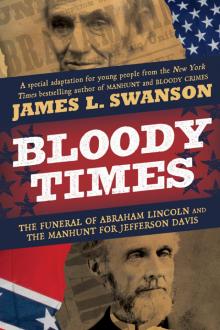 Bloody Times: The Funeral of Abraham Lincoln and the Manhunt for Jefferson Davis
Bloody Times: The Funeral of Abraham Lincoln and the Manhunt for Jefferson Davis Bloody Crimes: The Funeral of Abraham Lincoln and the Chase for Jefferson Davis
Bloody Crimes: The Funeral of Abraham Lincoln and the Chase for Jefferson Davis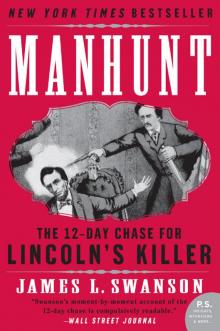 Manhunt: The 12-Day Chase for Lincoln's Killer
Manhunt: The 12-Day Chase for Lincoln's Killer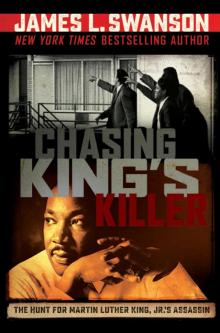 Chasing King's Killer: The Hunt for Martin Luther King, Jr.'s Assassin
Chasing King's Killer: The Hunt for Martin Luther King, Jr.'s Assassin Bloody Crimes
Bloody Crimes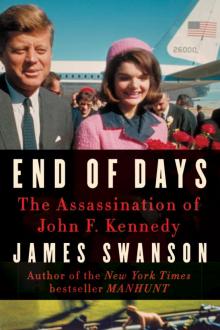 End of Days
End of Days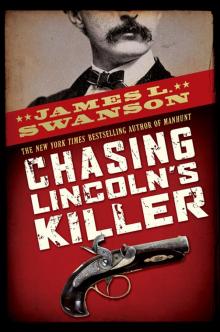 Chasing Lincoln's Killer
Chasing Lincoln's Killer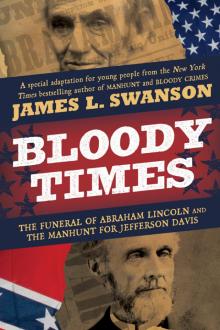 Bloody Times
Bloody Times Manhunt
Manhunt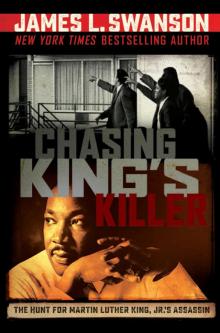 Chasing King's Killer
Chasing King's Killer